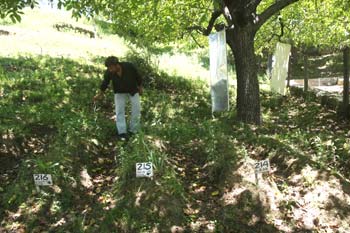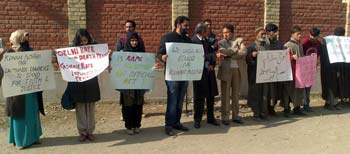Covert COVERAGE
 According to a report published in Argentinean daily, Buenos Aires Herald, Argentina sent a forensic team “secretly” to Kashmir in 2012 to investigate the surfacing of mass graves.
According to a report published in Argentinean daily, Buenos Aires Herald, Argentina sent a forensic team “secretly” to Kashmir in 2012 to investigate the surfacing of mass graves.
Quoting human rights activist, Mary Aileen D Bacalso, who is the Secretary-General of the Asian Federation Against Involuntary Disappearances (AFAD), the newspaper said that the team couldn’t do much there “as Muslims are against exhumations.”
Responding to a query regarding the Asian countries with worst human rights records, Bacalso, a Filipino by birth, told the newspaper; “Sri Lanka is very bad, one third of the population was killed during the recent civil war and there are thousands of disappeared. In the Kashmir region of India, where there are mass graves, there are 98,000 cases. Argentina sent a forensic team secretly to investigate mass graves last year. But it’s very difficult because the Muslims are against exhumations.”
A senior police officer told a local daily that the team was not on secret, but official visit. The officer said the team visited three places in Kashmir in July-August 2012. These included Bijhama, Kalaroos and Rajouri. “They talked to many people there regarding mass graves,” the official said adding that the team members, however, didn’t contact the police at official level. “They were here for around 17 days,” he said.
In August 2011, for the first time in Jammu and Kashmir, an official inquiry said that it is “beyond doubt” that there are scores of unidentified bodies lying unmarked graves in the Valley. It said as many as 2156 bodies are buried at 38 sites since the militancy began in 1990.
All these bodies, according to an inquiry by the investigative wing of the J&K State Human Rights Commission (SHRC), were handed over by the police to the local population for burial with bullet injuries and were classified as “unidentified militants.”
SHRC called for a thorough investigation across the state, FIRs, exhumation and prompt DNA profiling of the bodies and comparison of samples with those taken from residents who have been campaigning against the disappearance of their relatives.
Founded in 1998, AFAD is jointly working with the UN on the issue of disappeared persons in conflict areas. The Association has 11 member organizations around Asia including those from Bangladesh, India, Nepal, Thailand and Sri Lanka.
Revisiting BUNKERS
 Bunkers are coming back on the scene. At least, 18 new bunkers of paramilitary Central Reserve Police Force have come up since last week on the Srinagar Bypass road.
Bunkers are coming back on the scene. At least, 18 new bunkers of paramilitary Central Reserve Police Force have come up since last week on the Srinagar Bypass road.
The bunkers have been established on the 14-km stretch from Pantha Chowk to Parimpora on the Bypass Road. Officials describe the move as “reorganization of its deployment on the stretch to ensure safety of security vehicles and forces passing through the area.”
The new bunkers, made of piled up sandbags, are situated at less than one kilometre distance from each other. At most of the places on the Bypass Road, these bunkers have been established near residential houses or commercial establishments, risking the lives of local residents.
Half of the road near a bunker has been occupied by the CRPF with razor wire, which is a source of huge inconvenience for the locals who often complain of mishaps as a consequence.
Pertinently, people in Srinagar have been demanding removal of bunkers continuously for the past three years. While the CRPF authorities claim they have removed “most of the bunkers in the city”, the ground situation belies the claim.
Kishore Prasad, Public Relations Officer of CRPF, said the “step has been taken for strengthening the vigil on the Bypass.” Police records maintain that Bypass witnessed four attacks this year by suspected militants, leading to death of 15 forces personnel, including eight Army soldiers, six CRPF and one BSF personnel.
However, the re-establishment of bunkers has drawn flak from general public. “Both Government of India and the J&K Government have been making tall claims on demilitarization. But all this seems to be a big lie,” said residents of Rawalpora.
Last CHANCE
 Army was given one “last opportunity” by a local court of Kupwara to file its objections to an order seeking reinvestigation into the alleged mass rape of 1991 in Kunan and Poshpora villages of north Kashmir’s Kupwara district.
Army was given one “last opportunity” by a local court of Kupwara to file its objections to an order seeking reinvestigation into the alleged mass rape of 1991 in Kunan and Poshpora villages of north Kashmir’s Kupwara district.
The Army had filed a revision petition in the court challenging the June 18 order of the court of Judicial Magistrate Kupwara which directed police to “reinvestigate the case and conduct test identification parade” of the army personnel allegedly involved in the case.
The Army had contested the court order on the grounds that conducting test identification parade in the facts and circumstances of the case would be a “futile exercise and it would be unreasonable to conduct the parade as the identity of the persons after 23 years would have undergone substantial change in physical features.”
The victims’ families however opposed the revision petition following which the court, on the last hearing in the case, asked the Army to file objections against it on December 19.
Though police had closed the case as ‘untraced’, the Kupwara session court directed it to get it reinvestigated to “unravel the identity of those who happen to be the perpetrators.”
Counsel for victims’ families, Parvez Imroz, argued that for the past 22 years, they were waiting for justice and now the Army was “dillydallying” filing the objections. “Five of the victims have already died,” Imroz said. On Army’s revision petition, he said that they could oppose the prosecution under the Armed Forces Special Powers Act (AFSPA) but they “have no right to oppose the investigation” under the law.
“Nothing has been done so far and we apprehend that they will seek another extension merely as an eye-wash,” said Imroz.
The Support Group for Justice for Kunan-Poshpora, the Village Committees and the J&K Coalition of Civil Society led by Khurram Parvez staged a silent protest here. “We will not give in till victims and their families get justice,” Khurram said.
At least 40 women were allegedly raped by personnel of Army’s 4 Rajputana Rifles during the intervening night of February 23/24 in 1991 in the twin villages. In October 2011 the State Human Rights Commission recommended to the State Government to reopen the case and constitute a Special Investigation Team headed by an officer not below the rank of Superintendent of Police to reinvestigate the case.
‘Handholding’ YOUTH
 Describing youth the architect of future and agents of change towards positivity and betterment, Chief Minister, Omar Abdullah Monday said that schools nurture the young talent at their early age and universities give rise to best possible human resources to lead the country and address public affairs with energy and commitment.
Describing youth the architect of future and agents of change towards positivity and betterment, Chief Minister, Omar Abdullah Monday said that schools nurture the young talent at their early age and universities give rise to best possible human resources to lead the country and address public affairs with energy and commitment.
Interacting with students after unveiling the old foundation stone of the New University Campus of University of Jammu laid by Late Sheikh Mohammad Abdullah on December 16, 1976, the Chief Minister who is also Pro Vice Chancellor of Jammu University said that educationally prosperous Jammu and Kashmir was the dream of Sheikh Abdullah who always held education sector as the most important concern in his life and laid strong edifice for educational development in Jammu and Kashmir.
“My endeavour is to work for realization of the vision of educated Jammu and Kashmir envisioned by Late Sheikh Sahib,” he said and added that the holistic development in respect of expansion and consolidation of school and higher education during the last about five years have been phenomenally conspicuous and made the mark on ground.
“Today our universities and higher educational institutions are on road to excellence. These are emerging as educational hub attracting attention of higher education seekers from all over the country,” he said and added that introduction of modern subjects and strengthening of faculties and infrastructure has provided necessary fillip to the growth and development of higher education in the State.
Omar said that about one lakh educated youth have been provided jobs during the last about 5 years and the process of creating job opportunities for the youth in government departments and in the private sector is on. He, however, said that the answer to employment crisis has to be found through a multi-pronged strategy on which his government is working through and through.
The Chief Minister mentioned the avenues of self-employment and entrepreneurship created through the innovative initiative of SKEWPY and implementation of schemes like ‘Udaan’ and ‘Himayat’ for the youth to expand their opportunities to get jobs in the open job market. He reiterated his endeavour of handholding youth for their holistic development as above all political motives and said that whether in government or outside he will continue to work for the welfare and development of youth irrespective of any consideration.















